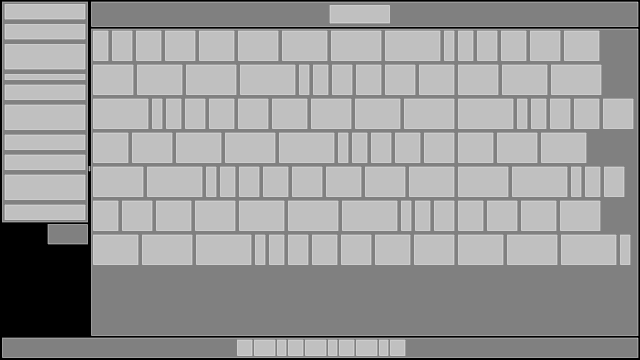A simple/fast stacking box layout library. It's useful for calculating layouts for things like 2D user interfaces. It compiles as C99 or C++. It's tested with gcc (mingw64), VS2015, and clang/LLVM. There are only two important files, layout.h and layout.c.
Layout has no external dependencies, but does use stdlib.h and string.h
for realloc and memset. If your own project does not or cannot use these,
you can easily exchange them for something else. Only a few lines will need to
be edited.
Layout comes with a small set of tests as a build target, along with a primitive benchmark and example usage of the library as a Lua .dll module. However, if you want to use Layout in your own project, you can probably copy layout.h and layout.c into your project's source tree and use your own build system. You don't have to separately build Layout as a shared library and link against it.
Building the tests, benchmarks and Lua module are handled by GENie, but no executable binaries for GENie are included in this source repository. Download links for binary builds of GENie are listed below. You will need to download (or build yourself) a GENie executable and place it in your path or at the root of this repository tree. If you want to build on a platform other than Windows, you'll likely need to modify genie.lua for compatibility. Feel free to open issues or pull requests.
Layout is based on the nice library oui by duangle. Unlike oui, Layout does not handle anything related to user input, focus, or UI state.
If you just want to use Layout in your own project, you can simply copy layout.h and layout.c directly into your project. Take a look at genie.lua for some recommended compiler and linker options.
If you want to build Layout's tests, benchmarks, or example Lua module, you will first need to get (or make) a GENie binary and place it in your path or at the root of this repository.
Linux:
https://github.com/bkaradzic/bx/raw/master/tools/bin/linux/genie
OSX:
https://github.com/bkaradzic/bx/raw/master/tools/bin/darwin/genie
Windows:
https://github.com/bkaradzic/bx/raw/master/tools/bin/windows/genie.exe
genie.exe vs2015
start build/vs2015/layout.sln
./genie gmake
and then run your make in the directory build/gmake. You will need to
specify a target and config. Here is an example for building the tests target
in Windows with the 64-bit release configuration using mingw64 in a bash-like
shell (for example, git bash):
./genie.exe gmake && mingw32-make.exe -C build/gmake tests config=release64
You can choose to build Layout to use either integer (int16) or floating
point (float) coordinates. Integer is the default, because UI and other 2D
layouts do not often use units smaller than a single point when aligning and
positioning elements. You can choose to use floating point instead of integer
by defining LAY_FLOAT. If you are building the tests, benchmarks, or Lua
module for Layout, you can configure this when you invoke GENie:
./genie gmake --coords=float
or if you want to specify integer (the default):
./genie gmake --coords=integer
If you are building Layout to use floating point coordinates, and if you want
to enforce SSE alignment for the vector coordinate types, you'll probably want
to add or tweak alignment specifiers for some types (or typedef them to m128)
in layout.h. The code is simple and should be easy to modify for
your purposes. If you do this, and if you also change the code to use your own
custom allocator, you might also need to guarantee that the starting addresses
of the buffers given to Layout by your allocator are 16-byte aligned. If you
do all of that, and if you build Layout as a shared library or a static
library without linker optimizations enabled in MSVC, you might want to also
consider using __vectorcall, which may help reduce overhead when calling
functions which receive or return SSE values.

